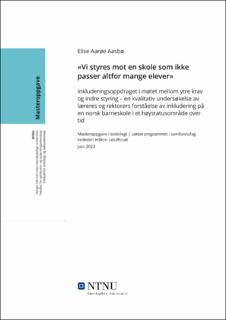| dc.contributor.advisor | Leiulfsrud, Håkon | |
| dc.contributor.author | Aasbø, Elise Aarøe | |
| dc.date.accessioned | 2022-08-30T17:19:52Z | |
| dc.date.available | 2022-08-30T17:19:52Z | |
| dc.date.issued | 2022 | |
| dc.identifier | no.ntnu:inspera:104661660:24579952 | |
| dc.identifier.uri | https://hdl.handle.net/11250/3014549 | |
| dc.description.abstract | Denne studien tar utgangspunkt i inklusjonsproblematikken i det norske utdanningssystemet. Til tross for en global enighet angående inkludering som formål og ideal, viser forskning til at sosial ulikhet reproduseres. Et formål med denne studien har vært å gå inn i tematikken med en lokal tilnærming og undersøke forståelsen og praktiseringen av inkluderingsoppdraget i én skole over tid i møtet mellom ytre og indre forhold.
Med inspirasjon fra et teoretisk rammeverk basert på ny-institusjonell teori, skolekultur og Axel Honneths anerkjennelsesteori har denne studien et organisatorisk perspektiv. Forskningsspørsmålene som blir aktualisert er (1) Hvilke forutsetninger ligger i personalets evne til samarbeid og forandring? og (2) Hva er det som anerkjennes og miskjennes i skolen over tid? Datamaterialet bygger på gjennomførte dybdeintervju med rektorer og lærere fra tidsperioden 2002, 2009 og 2019 på en skole i et høystatusområde.
Resultatene peker på at skolen opplever forventninger og et faglig press utenfra, samtidig som en fast og tradisjonell skolekultur i høy grad sementerer skolens indre normer. Skolens praktiske arbeid med inkludering blir dermed påvirket av både indre og ytre forhold. Studien nyanserer og utfordrer samtidig eksisterende teori i henhold til sosial reproduksjon. Skolen reproduserer ikke nødvendigvis elevenes oppvekstverdier i sin daglige praksis. Inklusjonsarbeidet går gjennom assimilering og tilpasning til skolens kultur, framfor å vektlegge og anerkjenne individuelle verdier.
Studiens funn viser at en generell inklusjonsforståelse ikke tar høyde for mangfoldet av alle elever. I en skole lokalisert i et høystatusområde, ble det ikke tilstrekkelig å kun forstå elevene som sliter og faller utenfor dersom alle elever med sine individuelle verdier skal anerkjennes og inkluderes. Det ble med andre ord mulig å synliggjøre et spenningsforhold mellom en generell inklusjonsforståelse og anerkjennelse. Spenningsforholdet vitner om en forståelse av sosial inklusjon som hovedsakelig er dominert av sosial reproduksjonsteori, der elevenes sosioøkonomiske bakgrunn tilskriver elevgrupper fordeler og ulemper. En mer nyansert og individualistisk inklusjonsforståelse, som tar høyde for mangfold i en bredere forstand, blir dermed nødvendig dersom alle elever skal anerkjennes og inkluderes.
Å tilnærme seg inklusjonsproblematikken med et organisatorisk perspektiv er et grep som i større grad tar hensyn til ulike og unike organisatoriske variasjoner. I lengden kan dette legge til rette for et inkluderingsarbeid som tar skolenes forhold i betraktning. | |
| dc.description.abstract | This study is based on the problematic aspects with inclusion in the Norwegian educational system. Despite the global consensus considering inclusion as a purpose and ideal, research shows that social inequality is reproduced. A purpose of this study has been to explore the topic with a local approach by examining the understanding and practice of inclusion in a particular school over time in the meeting point between external and internal conditions.
With a theoretical framework based on new institutional theory, school culture and Axel Honneth’s theory of recognition, this study has an organizational perspective. The research questions that are investigated are (1) What kind of preconditions lie in the staff’s ability to cooperate and change? and (2) What is recognized and what is not recognized in the school’s culture over time? The data material is based on conducted in-depth interviews with principals and teachers from 2002, 2009 and 2019 from one school in a high-status area.
The results show that the school is experiencing a professional pressure from the outside, at the same time as a traditional school culture cements the inner norms of the school. The practical work with inclusion thus is affected both by outer and inner conditions. At the same time, the study nuances and challenges existing social reproduction theory. The school does not necessarily reproduce the pupil’s home conditions in their daily practice. The work with inclusion is mainly done through assimilation and adaption to the school’s culture rather than by emphasizing and acknowledging individual values.
The study’s findings indicate that a general understanding of inclusion does not consider the diversity of all pupils. In a school that is located in a high-status area, it was not sufficient just to consider the pupils “who struggle” if all individual values are to be recognized and included. In other words, this study revealed a suspense between a general understanding of inclusion and recognition. This shows an understanding dominated by social reproduction theory where the pupils are attributed advantages and disadvantages based on their socioeconomic status. A nuanced and individualistic understanding of inclusion which considers diversity is necessary if all pupils are to be recognized and included.
Approaching the problematic aspect about inclusion with an organizational perspective is a measure that to a greater extent considers different and unique organizational variations. In the long run this can facilitate inclusive work in schools, where the specific school conditions are taken into account. | |
| dc.language | nob | |
| dc.publisher | NTNU | |
| dc.title | «Vi styres mot en skole som ikke passer altfor mange elever» | |
| dc.type | Master thesis | |
